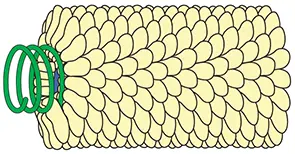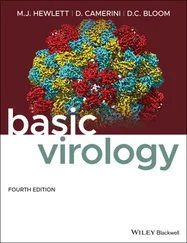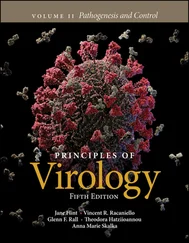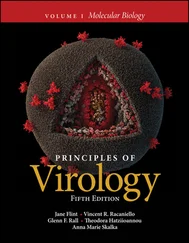Jane Flint - Principles of Virology
Здесь есть возможность читать онлайн «Jane Flint - Principles of Virology» — ознакомительный отрывок электронной книги совершенно бесплатно, а после прочтения отрывка купить полную версию. В некоторых случаях можно слушать аудио, скачать через торрент в формате fb2 и присутствует краткое содержание. Жанр: unrecognised, на английском языке. Описание произведения, (предисловие) а так же отзывы посетителей доступны на портале библиотеки ЛибКат.
- Название:Principles of Virology
- Автор:
- Жанр:
- Год:неизвестен
- ISBN:нет данных
- Рейтинг книги:3 / 5. Голосов: 1
-
Избранное:Добавить в избранное
- Отзывы:
-
Ваша оценка:
- 60
- 1
- 2
- 3
- 4
- 5
Principles of Virology: краткое содержание, описание и аннотация
Предлагаем к чтению аннотацию, описание, краткое содержание или предисловие (зависит от того, что написал сам автор книги «Principles of Virology»). Если вы не нашли необходимую информацию о книге — напишите в комментариях, мы постараемся отыскать её.
Volume I: Molecular Biology
Volume II: Pathogenesis and Control
Principles of Virology, Fifth Edition
Principles of Virology — читать онлайн ознакомительный отрывок
Ниже представлен текст книги, разбитый по страницам. Система сохранения места последней прочитанной страницы, позволяет с удобством читать онлайн бесплатно книгу «Principles of Virology», без необходимости каждый раз заново искать на чём Вы остановились. Поставьте закладку, и сможете в любой момент перейти на страницу, на которой закончили чтение.
Интервал:
Закладка:
Viral Pathogenesis
Viruses command our attention because of their association with animal and plant diseases. Viral pathogenesisis the process by which viruses cause disease. The study of viral pathogenesis requires investigating not only the relationships of viruses with the specific cells that they infect but also the consequences of infection for the host organism. The nature of viral disease depends on the effects of viral reproduction on host cells, the responses of the host’s defense systems, and the ability of the virus to spread in and among hosts (Volume II, Chapters 1to 5).
BOX 2.1
EXPERIMENTS
In vitro assembly of tobacco mosaic virus
The ability of the primary sequence of viral structural proteins to specify assembly is exemplified by the coat protein of tobacco mosaic virus. Heinz Fraenkel-Conrat and Robley Williams showed in 1955 that purified tobacco mosaic virus RNA and capsid protein assemble into infectious particles when mixed and incubated for 24 h. When examined by electron microscopy, the particles produced in vitro were found to be identical to the rod-shaped particles produced from infected tobacco plants ( Fig. 1.9B). Neither the purified viral RNA nor the capsid protein alone was infectious. The spontaneous formation of tobacco mosaic particles in vitro from protein and RNA components is theparadigm for self-assembly in biology.
Fraenkel-Conrat H, Williams RC. 1955. Reconstitution of active tobacco mosaic virus from its inactive protein and nucleic acid components. Proc Natl Acad Sci U S A 41:690–698.

Overcoming Host Defenses
Organisms have many physical barriers to protect themselves from dangers in their environment, such as invading parasites. Vertebrates also possess an immune system to defend against anything recognized as foreign. Studies of the interactions between viruses and the immune system are particularly instructive, because of the many viral countermeasures that can frustrate this system. Elucidation of these measures continues to teach us about the basis of immunity (Volume II, Chapters 2to 4).
Cultivation of Viruses
Cell Culture
Types of Cell Culture
Although human and other animal cells were first cultured in the early 1900s, contamination with bacteria, mycoplasmas, and fungi initially made routine work with such cultures extremely difficult. For this reason, most viruses were produced in laboratory animals. The use of antibiotics in the 1940s to control microbial infection was crucial to the establishment of the first cell lines, such as mouse L929 cells (1948) and HeLa cells (1951). John Enders, Thomas Weller, and Frederick Robbins discovered in 1949 that poliovirus could multiply in cultured cells. As noted in Chapter 1, this revolutionary finding, for which these three investigators were awarded a Nobel Prize in 1954, led the way to the propagation of many other viruses in cells in culture, the discovery of new viruses, and the development of vaccines such as those against the viruses that cause poliomyelitis, measles, and rubella. The ability to infect cultured cells synchronously permitted studies of the biochemistry and molecular biology of viral reproduction. Large-scale propagation and purification of virus particles allowed studies of the composition of virus particles, leading to the solution of high-resolution, three-dimensional structures (see Chapter 4).
Cells in culture are still the most commonly utilized hosts for the propagation of animal viruses. To prepare a cell culture, tissues are dissociated into a single-cell suspension by mechanical disruption followed by treatment with proteolytic enzymes. The cells are then suspended in culture medium and placed in specialized plastic flasks or covered plates. As the cells divide, they cover the plastic surface. Epithelial and fibroblastic cells attach to the plastic and form a monolayer, whereas blood cells such as lymphocytes settle but do not adhere. The cells are grown in a chemically defined and buffered medium optimal for their growth. Commonly used cell lines double in number in 24 to 48 h in such media. Most cells retain viability after being frozen at low temperatures (−70 to −196°C).
There are three main kinds of monolayer cell cultures ( Fig. 2.2), each with advantages and disadvantages for virus research. Primary cell culturesare prepared from animal tissues as described above. They have a limited life span, usually no more than 5 to 20 cell divisions. Commonly used primary cell cultures are derived from chicken or mouse embryos, monkey kidneys, or human tissues that are otherwise typically disposed of, such as embryonic amnion, kidney, foreskin, and respiratory epithelium. Such cells are used for experimental virology when the state of cell differentiation is important or when appropriate cell lines are not available. They are also used in vaccine production: for example, infectious attenuated poliovirus vaccine strains may be propagated in primary monkey kidney cells. Primary cell cultures are used for the propagation of viruses to be used as human vaccines to avoid contamination of the product with potentially oncogenic DNA from continuous cell lines (see below). Some viral vaccines are now prepared in diploid cell strains, which consist of a homogeneous population of a single cell type and can divide up to 100 times before dying. Despite the numerous divisions, these cells retain the diploid chromosome number. The most widely used diploid cells are those established from human embryos, such as the WI-38 strain derived from human embryonic lung.

Figure 2.2 Different types of cell culture used in virology. Confluent cell monolayers photographed by low-power light microscopy. (A)Primary human foreskin fibroblasts; (B)established line of mouse fibroblasts (3T3); (C)continuous line of human epithelial cells (HeLa [ Box 2.3]). The ability of transformed HeLa cells to overgrow one another is the result of a loss of contact inhibition. Courtesy of R. Gonzalez, Princeton University.
Continuous cell linesconsist of a single cell type that can be propagated indefinitely in culture. These immortal lines are usually derived from tumor tissue or by treating a primary cell culture or a diploid strain with a mutagenic chemical or an oncogene. Such cell lines often do not resemble the cell of origin; they are less differentiated (having lost the morphology and biochemical features that they possessed in the organ), are often abnormal in chromosome morphology and number ( aneuploid), and can be tumorigenic (i.e., they produce tumors when inoculated into immunodeficient mice). Examples of commonly used continuous cell lines include those derived from human carcinomas (e.g., HeLa [Henrietta Lacks] cells [ Box 2.2]) and from mice (e.g., L and 3T3 cells). Continuous cell lines provide a uniform population of cells that can be infected synchronously for growth curve analysis (see “The One-Step Growth Cycle” below) or biochemical studies of virus replication.
In contrast to cells that grow in monolayers on plastic dishes, others can be maintained in suspension cultures, in which a spinning magnet continuously stirs the cells. The advantage of suspension culture is that a large number of cells can be grown in a relatively small volume. This culture method is well suited for applications that require large quantities of virus particles, such as X-ray crystallography or production of vectors.
Читать дальшеИнтервал:
Закладка:
Похожие книги на «Principles of Virology»
Представляем Вашему вниманию похожие книги на «Principles of Virology» списком для выбора. Мы отобрали схожую по названию и смыслу литературу в надежде предоставить читателям больше вариантов отыскать новые, интересные, ещё непрочитанные произведения.
Обсуждение, отзывы о книге «Principles of Virology» и просто собственные мнения читателей. Оставьте ваши комментарии, напишите, что Вы думаете о произведении, его смысле или главных героях. Укажите что конкретно понравилось, а что нет, и почему Вы так считаете.











